
|
It brightened rapidly in December. Now it is bright as 9.6 mag (Mar. 17, Carlos Labordena). It will approach to Earth down to 0.46 a.u. in April, and it will be observable at 9 mag in excellent condition.
Date(TT) R.A. (2000) Decl. Delta r Elong. m1 Best Time(A, h)
Mar. 20 20 17.58 -6 59.3 1.261 1.072 55 10.3 4:39 (296, 22)
Mar. 27 20 3.46 -4 8.2 1.062 1.111 65 10.1 4:29 (300, 29)
|

|
Now it is very bright as 11.0 mag (Mar. 2, Piotr Guzik). In the Northern Hemisphere, it stays observable in the evening low sky until early June while the comet will be fading. It is not observable in the Southern Hemisphere.
Date(TT) R.A. (2000) Decl. Delta r Elong. m1 Best Time(A, h)
Mar. 20 1 7.43 25 39.4 1.671 0.964 30 11.5 19:35 (114, 11)
Mar. 27 1 46.36 28 58.6 1.693 1.016 33 11.7 19:42 (116, 14)
|
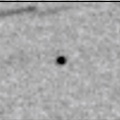
|
Now it is 14.4 mag (Mar. 8, Slooh.com Chile Observatory, La Dehesa). Appearing in the morning sky in the Southern Hemisphere. In the Northern Hemisphere, it will appear in the morning sky in June.
Date(TT) R.A. (2000) Decl. Delta r Elong. m1 Best Time(A, h)
Mar. 20 22 11.04 -12 59.3 2.195 1.413 29 11.6 4:39 (283, -4)
Mar. 27 22 34.20 -11 30.9 2.179 1.413 30 11.6 4:29 (281, -4)
|
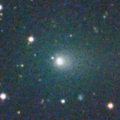
|
It brightened rapidly. Now it is very bright as 12.8 mag (Mar. 8, Michael Jager). It stays observable at 11 mag in good condition for a long time from spring to summer.
Date(TT) R.A. (2000) Decl. Delta r Elong. m1 Best Time(A, h)
Mar. 20 14 7.30 33 21.8 1.641 2.448 135 12.3 2:18 ( 0, 88)
Mar. 27 14 5.76 33 57.7 1.584 2.406 136 12.1 1:49 ( 0, 89)
|

|
Now it is bright as 12.9 mag (Feb. 9, Chris Wyatt). It stays 12 mag until March. In the Southern Hemisphere, it stays observable in good condition after this. In the Northern Hemisphere, it will never be observable after this.
Date(TT) R.A. (2000) Decl. Delta r Elong. m1 Best Time(A, h)
Mar. 20 3 21.40 -75 51.2 2.127 2.201 80 12.6 19:35 ( 14,-27)
Mar. 27 3 34.65 -71 52.1 2.197 2.256 80 12.7 19:42 ( 19,-26)
|
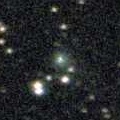
|
Now it is 12.8 mag (Mar. 9, W. Pei). It will brighten up to 10 mag in winter in 2022. In the Northern Hemisphere, it stays observable in good condition for a long time. In the Southern Hemisphere, it is not observable until November.
Date(TT) R.A. (2000) Decl. Delta r Elong. m1 Best Time(A, h)
Mar. 20 1 58.67 51 23.2 4.882 4.430 57 13.0 19:35 (134, 31)
Mar. 27 2 11.03 51 13.6 4.910 4.394 53 13.0 19:42 (135, 28)
|
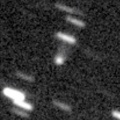
|
Now it is 14.9 mag (Feb. 11, iTelescope Observatory, Siding Spring). It will brighten up to 13 mag from spring to summer. In the Southern Hemisphere, it stays observable in good condition for a long time. In the Northern Hemisphere, it is not observable until July in 2022.
Date(TT) R.A. (2000) Decl. Delta r Elong. m1 Best Time(A, h)
Mar. 20 18 41.29 -63 36.2 3.650 3.697 84 13.5 4:39 (346,-12)
Mar. 27 18 56.45 -65 18.6 3.567 3.683 88 13.4 4:29 (347,-13)
|
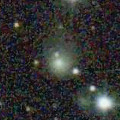
|
Now it is 13.3 mag (Mar. 17, Toshihiko Ikemura, Hirohisa Sato). It is expected to be observable at 5-6 mag for a long time from 2022 to 2023. In the Northern Hemisphere, it is not observable at the high light from 2022 summer to 2023 summer. In the Southern Hemisphere, it stays extremely low for a while. But it will be observable in good condition at the high light.
Date(TT) R.A. (2000) Decl. Delta r Elong. m1 Best Time(A, h)
Mar. 20 18 27.39 38 20.6 6.850 6.824 84 13.5 4:39 (253, 66)
Mar. 27 18 28.03 38 57.3 6.738 6.768 87 13.4 4:29 (251, 69)
|
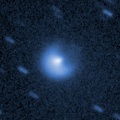
|
Now it is 13.2 mag (Mar. 6, Thomas Lehmann). It is already unobservable in the Southern Hemisphere. It will be unobservable in April also in the Northern Hemisphere.
Date(TT) R.A. (2000) Decl. Delta r Elong. m1 Best Time(A, h)
Mar. 20 2 45.66 24 42.0 6.489 5.866 47 13.8 19:35 (101, 29)
Mar. 27 2 50.81 24 56.7 6.570 5.867 42 13.9 19:42 (105, 24)
|
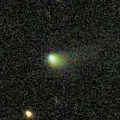
|
Now it is 14.7 mag (Feb. 17, iTelescope Observatory, Siding Spring). It stays 13-14 mag from 2020 to 2021. It will be observable in good condition after this in the Southern Hemisphere. It locates somewhat low in the Northern Hemisphere.
Date(TT) R.A. (2000) Decl. Delta r Elong. m1 Best Time(A, h)
Mar. 20 18 46.64 -23 34.9 2.892 2.867 78 14.0 4:39 (326, 23)
Mar. 27 18 54.94 -23 53.4 2.802 2.869 83 13.9 4:29 (328, 24)
|

|
It brightened up to 10.5 mag in early February (Feb. 6, Marco Goiato). Now it is fading rapidly. It has already faded down to 14.6 mag (Mar. 6, Michael Jager). In the Northern Hemisphere, it stays observable for a long time after this. In the Southern Heimsphere, it will never be observable again.
Date(TT) R.A. (2000) Decl. Delta r Elong. m1 Best Time(A, h)
Mar. 20 5 0.55 45 32.6 1.465 1.626 80 14.1 19:35 (122, 60)
Mar. 27 4 58.87 47 39.7 1.648 1.677 74 14.6 19:42 (125, 54)
|
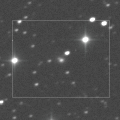
|
Now it is 14.3 mag (Mar. 9, iTelescope Observatory, Siding Spring). It will brighten up to 13.5 mag in spring. In the Southern Hemisphere, it stays observable in good condition for a long time. In the Northern Hemisphere, it will be getting higher and becoming observable slowly.
Date(TT) R.A. (2000) Decl. Delta r Elong. m1 Best Time(A, h)
Mar. 20 17 32.88 -39 22.9 3.138 3.367 94 14.3 4:39 (347, 14)
Mar. 27 17 24.09 -39 1.2 2.994 3.362 102 14.1 4:29 (352, 15)
|
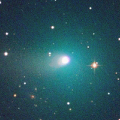
|
Brightened rapidly, and it brightened up to 9.7 mag in November (Nov. 15, Chris Wyatt). Now it is fading. It has already faded down to 13.1 mag (Mar. 6, Thomas Lehmann). In the Northern Hemisphere, it stays observable in good condition for a long time. In the Southern Hemisphere, it locates extremely low after this.
Date(TT) R.A. (2000) Decl. Delta r Elong. m1 Best Time(A, h)
Mar. 20 5 6.72 40 53.8 1.779 1.892 80 14.3 19:35 (113, 62)
Mar. 27 5 27.32 40 45.2 1.888 1.941 77 14.6 19:42 (112, 60)
|

|
It brightened up to 5.6 mag in early December (Dec. 9, Marco Goiato). In mid December, it was visible at about 3 mag in the SOHO spacecraft images (Dec. 18, Hirohisa Sato). Now it is not observable. It will appear in the morning sky again in April. But then it will be fainter than 15 mag.
Date(TT) R.A. (2000) Decl. Delta r Elong. m1 Best Time(A, h)
Mar. 20 22 55.65 6 3.4 2.935 2.002 16 14.4 4:39 (261, -2)
Mar. 27 23 6.61 7 20.9 3.021 2.108 19 14.6 4:29 (261, 0)
|

|
Now it is 14.6 mag (Mar. 2, ATLAS-MLO, Mauna Loa). It is expected to brighten up to 11.5 mag in 2022. It is observable in excellent condition in the Southern Hemisphere. In the Northern Hemisphere, it is observable in the low sky until May.
Date(TT) R.A. (2000) Decl. Delta r Elong. m1 Best Time(A, h)
Mar. 20 7 58.91 -35 28.6 5.096 5.578 114 14.5 20:06 ( 0, 20)
Mar. 27 7 59.19 -34 26.1 5.104 5.542 111 14.4 19:42 ( 1, 21)
|

|
Now it is 14.6 mag (Mar. 15, Thomas Lehmann). Brightenening very rapidly. It will brighten up to 11 mag from May to August. In the Southern Hemisphere, it stays observable in excellent condition for a long time. In the Northern Hemisphere, it stays observable in good condition for a while. But it becomes extremely low after July.
Date(TT) R.A. (2000) Decl. Delta r Elong. m1 Best Time(A, h)
Mar. 20 17 15.18 9 34.7 0.931 1.482 100 14.9 4:39 (335, 63)
Mar. 27 17 35.82 9 20.4 0.861 1.439 101 14.5 4:29 (333, 62)
|
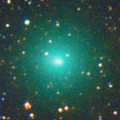
|
It brightened up to 8.2 mag in autumn (Oct. 13, Chris Wyatt). Now it is fading. It has already faded down to 13.0 mag (Feb. 14, Sandor Szabo). It is not observable after this.
Date(TT) R.A. (2000) Decl. Delta r Elong. m1 Best Time(A, h)
Mar. 20 1 10.14 5 46.5 3.124 2.207 19 14.6 19:35 ( 97, 0)
Mar. 27 1 23.42 7 13.1 3.198 2.254 15 14.8 19:42 (101, -3)
|
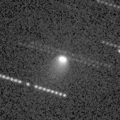
|
It brightening very rapidly up to 12.5 mag in early February (Feb. 8, Michael Jager). Now it is fading. But it is still bright as 12.3 mag (Mar. 2, Michael Jager). In the Northern Hemisphere, it stays observable in excellent condition. It will be observable in good condition after this also in the Southern Hemisphere.
Date(TT) R.A. (2000) Decl. Delta r Elong. m1 Best Time(A, h)
Mar. 20 4 14.57 -1 58.1 1.145 1.146 64 14.6 19:35 ( 61, 32)
Mar. 27 4 12.86 -5 19.8 1.311 1.151 57 14.9 19:42 ( 65, 23)
|
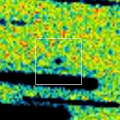
|
It will brighten up to 13 mag from spring to summer. In the Southern Hemisphere, it stays observable in good condition for a long time. In the Northern Hemisphere, it is not observable until September when it fades down to 15 mag.
Date(TT) R.A. (2000) Decl. Delta r Elong. m1 Best Time(A, h)
Mar. 20 20 35.17 -34 43.8 2.184 1.865 58 14.9 4:39 (314, 0)
Mar. 27 20 58.50 -36 47.7 2.063 1.814 61 14.7 4:29 (314, -3)
|
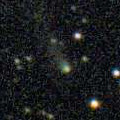
|
Now it is 15.9 mag (Mar. 7, Thomas Lehmann). It will stay at 14 mag for a long time from 2021 to 2022. It stays observable in good condition after this while brightening gradually. Although it was observed at 15 mag in 2020 autumn, it is fainter than this ephemeris recently.
Date(TT) R.A. (2000) Decl. Delta r Elong. m1 Best Time(A, h)
Mar. 20 18 23.47 2 5.1 5.309 5.290 83 14.8 4:39 (315, 48)
Mar. 27 18 22.72 1 55.6 5.178 5.273 89 14.7 4:29 (320, 50)
|

|
Now it is 15.8 mag (Jan. 14, Slooh.com Chile Observatory, La Dehesa). It stays 14-15 mag until the end of 2021. In the Southern Hemisphere, it stays observable in good condition for a long time, although it becomes extremely low temporarily from January to February. In the Northern Hemisphere, it is not observable until June.
Date(TT) R.A. (2000) Decl. Delta r Elong. m1 Best Time(A, h)
Mar. 20 22 39.95 -42 37.5 4.961 4.326 45 15.1 4:39 (306,-25)
Mar. 27 22 48.02 -41 37.9 4.913 4.326 49 15.1 4:29 (306,-23)
|
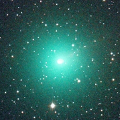
|
It brightened up to 7.3 mag in November (Nov. 7, Marco Goiato). Now it is fading. It has already faded down to 16.0 mag (Mar. 17, Toshihiko Ikemura, Hirohisa Sato). In the Northern Hemisphere, it stays observable in excellent condition for a long time. In the Southern Hemisphere, it stays locating extremely low after this.
Date(TT) R.A. (2000) Decl. Delta r Elong. m1 Best Time(A, h)
Mar. 20 6 46.12 45 58.9 2.008 2.372 98 15.1 19:35 (148, 77)
Mar. 27 6 58.31 45 18.7 2.156 2.444 94 15.5 19:42 (136, 74)
|

|
Now it is 15.8 mag (Jan. 16, Slooh.com Canary Islands Observatory). It is not observable until June.
Date(TT) R.A. (2000) Decl. Delta r Elong. m1 Best Time(A, h)
Mar. 20 23 48.87 6 51.5 3.075 2.091 7 15.2 4:39 (253,-12)
Mar. 27 0 2.97 8 55.5 3.081 2.098 8 15.2 4:29 (251,-10)
|

|
Now it is 16.3 mag (Nov. 9, Toshihiko Ikemura, Hirohisa Sato). It will brighten up to 14.5 mag from spring to summer. In the Southern Hemisphere, it stays observable in excellent condition for a long time, although it becomes extremely low temporarily from January to February. In the Northern Hemisphere, it is not observable after this.
Date(TT) R.A. (2000) Decl. Delta r Elong. m1 Best Time(A, h)
Mar. 20 23 6.20 -43 51.5 3.278 2.669 45 15.3 4:39 (305,-29)
Mar. 27 23 18.62 -45 18.4 3.192 2.661 49 15.2 4:29 (307,-29)
|

|
It had been observed as 8-9 mag for a long time in 2020. Now it is fading. It has already faded down to 16.1 mag (Feb. 25, Thomas Lehmann). It will be observable in good condition after this in the Southern Hemisphere. It locates extremely low after this in the Northern Hemisphere.
Date(TT) R.A. (2000) Decl. Delta r Elong. m1 Best Time(A, h)
Mar. 20 17 46.69 -36 55.0 3.965 4.121 91 15.2 4:39 (344, 16)
Mar. 27 17 46.96 -37 56.4 3.919 4.186 98 15.3 4:29 (347, 16)
|

|
Now it is 15.2 mag (Mar. 17, Giuseppe Pappa). It stays 15 mag until summer. In the Southern Hemisphere, it stays observable in good condition until June. In the Northern Hemisphere, it is observable in the low sky from March to May.
Date(TT) R.A. (2000) Decl. Delta r Elong. m1 Best Time(A, h)
Mar. 20 6 10.43 -40 30.6 2.169 2.422 92 15.5 19:35 ( 15, 13)
Mar. 27 6 17.97 -36 19.7 2.148 2.376 90 15.4 19:42 ( 21, 15)
|

|
It has not been observed yet in this apparition. It will brighten up to 10 mag from summer to autumn, and it will be observable in excellent condition. It will be appearing in the morning sky soon.
Date(TT) R.A. (2000) Decl. Delta r Elong. m1 Best Time(A, h)
Mar. 20 22 8.07 -6 28.3 3.153 2.321 27 15.7 4:39 (278, 1)
Mar. 27 22 21.80 -5 16.0 3.072 2.279 31 15.4 4:29 (278, 2)
|
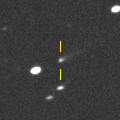
|
Now it is 15.9 mag (Mar. 18, Toshihiko Ikemura, Hirohisa Sato). It will brighten up to 13 mag in 2022. In 2021, it is observable at 15-16 mag in good condition.
Date(TT) R.A. (2000) Decl. Delta r Elong. m1 Best Time(A, h)
Mar. 20 13 37.48 -1 48.6 2.809 3.735 154 15.5 1:48 ( 0, 53)
Mar. 27 13 33.68 -1 28.3 2.756 3.719 162 15.5 1:17 ( 0, 53)
|
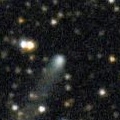
|
Now it is 15.4 mag (Mar. 16, Toshihiko Ikemura, Hirohisa Sato). It stays 15-16 mag until spring. In the Northern Hemisphere, it stays observable in good condition for a long time. In the Southern Hemisphere, it will be observable in the extremely low sky only in next spring.
Date(TT) R.A. (2000) Decl. Delta r Elong. m1 Best Time(A, h)
Mar. 20 19 22.18 36 51.4 5.190 4.997 73 15.6 4:39 (254, 55)
Mar. 27 19 22.11 38 42.6 5.152 5.022 76 15.6 4:29 (252, 59)
|

|
First return of a new periodic comet which brightened up to 14-15 mag in 2006. Now it is 15.3 mag (Mar. 18, Toshihiko Ikemura, Hirohisa Sato). It will brighten up to 15-16 mag from February to March, and will be observable in good condition.
Date(TT) R.A. (2000) Decl. Delta r Elong. m1 Best Time(A, h)
Mar. 20 13 21.07 17 34.0 0.895 1.839 153 15.7 1:32 ( 0, 72)
Mar. 27 13 20.91 19 10.1 0.914 1.863 154 15.9 1:04 ( 0, 74)
|

|
Now it is not observable. It will be observable in June. But it will fade down to 17 mag at that time.
Date(TT) R.A. (2000) Decl. Delta r Elong. m1 Best Time(A, h)
Mar. 20 23 14.00 -6 8.8 2.540 1.581 12 15.8 4:39 (269,-13)
Mar. 27 23 32.79 -3 23.0 2.539 1.589 13 15.8 4:29 (266,-11)
|
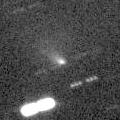
|
Now it is 16.0 mag (Mar. 10, Toshihiko Ikemura, Hirohisa Sato). It will be fading after this. In the Northern Hemisphere, it will be getting lower gradually, and will be too low to observe in May. It will be getting higher gradually in the Southern Hemisphere.
Date(TT) R.A. (2000) Decl. Delta r Elong. m1 Best Time(A, h)
Mar. 20 4 27.41 14 46.4 1.317 1.326 68 15.8 19:35 ( 75, 45)
Mar. 27 4 53.27 12 43.3 1.351 1.339 67 16.0 19:42 ( 74, 42)
|

|
First return of a new periodic comet which brightened up to 13 mag in 2009. It brightened up to 11.7 mag in January (Jan. 10, Marco Goiato). Now it is fading. It has already faded down to 16.7 mag (Mar. 17, Toshihiko Ikemura, Hirohisa Sato). It stays observable in good condition while the comet will be fading after this.
Date(TT) R.A. (2000) Decl. Delta r Elong. m1 Best Time(A, h)
Mar. 20 7 41.15 28 4.0 0.924 1.600 112 15.9 19:50 ( 0, 83)
Mar. 27 7 58.60 28 2.3 1.012 1.643 109 16.3 19:42 ( 3, 83)
|
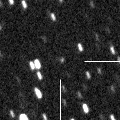
|
Now it is 16.3 mag (Mar. 18, Toshihiko Ikemura, Hirohisa Sato). In the Northern Hemisphere, it stays observable at 15 mag for a long time from spring to early 2022. In the Southern Hemisphere, it is not observable until the end of 2021.
Date(TT) R.A. (2000) Decl. Delta r Elong. m1 Best Time(A, h)
Mar. 20 20 19.22 58 7.2 3.523 3.359 72 16.1 4:39 (220, 46)
Mar. 27 20 19.44 60 38.8 3.464 3.329 73 16.0 4:29 (216, 48)
|

|
Now it is 15.4 mag (Mar. 17, Toshihiko Ikemura, Hirohisa Sato). In the Northern Hemisphere, it stays observable for a long time while it is getting fainter slowly. In the Southern Hemisphere, it will never be observable again.
Date(TT) R.A. (2000) Decl. Delta r Elong. m1 Best Time(A, h)
Mar. 20 16 9.87 68 12.8 5.232 5.492 99 16.1 4:19 (180, 57)
Mar. 27 15 58.42 68 50.9 5.280 5.540 99 16.1 3:41 (180, 56)
|

|
Now it is 16.3 mag (Mar. 16, Toshihiko Ikemura, Hirohisa Sato). It is expected to brighten up to 13 mag in 2022. In the Southern Hemisphere, it stays observable in good condition for a long time. In the Northern Hemisphere, it stays observable until June when it brightens up to 16 mag. But it will not be observable at the high light.
Date(TT) R.A. (2000) Decl. Delta r Elong. m1 Best Time(A, h)
Mar. 20 13 41.24 -20 9.5 4.349 5.216 147 16.4 1:52 ( 0, 35)
Mar. 27 13 33.85 -20 26.6 4.247 5.169 155 16.3 1:18 ( 0, 34)
|
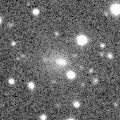
|
Brightened very rapidly up to 15.0 mag (Feb. 4, Michael Jager). Now it is fading. It hasl already faded down to 16.9 mag (Mar. 14, Toshihiko Ikemura, Hirohisa Sato). It is observable in good condition in the Northern Hemisphere. It locates low in the Southern Hemisphere.
Date(TT) R.A. (2000) Decl. Delta r Elong. m1 Best Time(A, h)
Mar. 20 5 0.89 28 15.3 1.955 1.996 77 16.5 19:35 ( 88, 59)
Mar. 27 5 17.44 28 13.0 2.044 2.019 74 16.7 19:42 ( 90, 55)
|

|
Now it is 16.5 mag (Feb. 9, Toshihiko Ikemura, Hirohisa Sato). It is observable at 16 mag from 2020 to 2021. In the Southern Hemisphere, it is not observable until summer.
Date(TT) R.A. (2000) Decl. Delta r Elong. m1 Best Time(A, h)
Mar. 20 22 58.90 42 36.8 6.612 5.948 44 16.5 4:39 (230, 18)
Mar. 27 23 2.58 42 33.3 6.627 5.949 43 16.5 4:29 (231, 20)
|
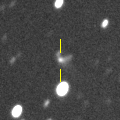
|
Now it is 15.5 mag (Mar. 14, Toshihiko Ikemura, Hirohisa Sato). It stays observable at 16 mag from 2021 to 2022.
Date(TT) R.A. (2000) Decl. Delta r Elong. m1 Best Time(A, h)
Mar. 20 14 23.37 -20 57.6 4.159 4.949 138 16.5 2:34 ( 0, 34)
Mar. 27 14 20.10 -19 43.6 4.069 4.932 146 16.5 2:03 ( 0, 35)
|
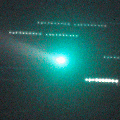
|
It brightened very rapidly in early December, and it brightened up to 10.0 mag in January (Jan. 7, Michael Jager). Now it is fading. However, it brightened in outburst in early March up to 12.9 mag (Mar. 3, Martin Masek). Now it is 14.1 mag (Mar. 15, Thomas Lehmann).
Date(TT) R.A. (2000) Decl. Delta r Elong. m1 Best Time(A, h)
Mar. 20 6 15.28 5 3.3 1.161 1.587 94 16.5 19:35 ( 33, 56)
Mar. 27 6 34.70 5 33.0 1.281 1.660 92 17.2 19:42 ( 39, 55)
|

|
Now it is 16.7 mag (Mar. 14, Toshihiko Ikemura, Hirohisa Sato). It is observable at 16.5 mag from spring in 2020 to summer in 2021.
Date(TT) R.A. (2000) Decl. Delta r Elong. m1 Best Time(A, h)
Mar. 20 17 47.05 -12 29.7 4.608 4.756 92 16.6 4:39 (335, 39)
Mar. 27 17 43.70 -12 55.3 4.492 4.769 100 16.6 4:29 (341, 40)
|
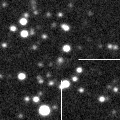
|
Now it is 16.2 mag (Mar. 16, Toshihiko Ikemura, Hirohisa Sato). It stays at 16-17 mag from 2020 to 2021. In the Northern Hemisphere, it stays observable in good condition for a long time. It is not observable in the Southern Hemisphere.
Date(TT) R.A. (2000) Decl. Delta r Elong. m1 Best Time(A, h)
Mar. 20 19 45.21 37 39.3 9.125 8.820 69 16.7 4:39 (251, 51)
Mar. 27 19 46.35 38 38.4 9.073 8.820 72 16.7 4:29 (251, 54)
|
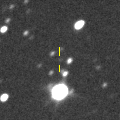
|
Now it is 16.2 mag (Mar. 16, Toshihiko Ikemura, Hirohisa Sato). It will brighten up to 16 mag from April to May, and it will be observable in good condition.
Date(TT) R.A. (2000) Decl. Delta r Elong. m1 Best Time(A, h)
Mar. 20 16 11.54 16 19.2 1.772 2.376 115 16.9 4:22 ( 0, 71)
Mar. 27 15 53.74 16 13.4 1.655 2.370 124 16.7 3:37 ( 0, 71)
|

|
Now it is 17.0 mag (Mar. 4, D. Husar). It will brighten up to 16.5 mag in summer.
Date(TT) R.A. (2000) Decl. Delta r Elong. m1 Best Time(A, h)
Mar. 20 17 36.75 -33 26.4 4.852 5.023 94 16.9 4:39 (345, 20)
Mar. 27 17 37.41 -32 49.8 4.725 5.010 100 16.9 4:29 (348, 21)
|

|
Now it is 17.7 mag (Mar. 6, ATLAS-MLO, Mauna Loa). It will be fading slowly.
Date(TT) R.A. (2000) Decl. Delta r Elong. m1 Best Time(A, h)
Mar. 20 18 27.57 -17 44.7 7.475 7.415 82 17.0 4:39 (327, 30)
Mar. 27 18 26.24 -17 23.5 7.372 7.438 89 17.0 4:29 (331, 32)
|

|
Now it is 17.5 mag (Feb. 23, Thomas Lehmann). Although it is an asteroid, it is brightening rapidly. It may brighten up to 11 mag in 2023. In the Northern Hemisphere, it stays observable in good condition for a long time. It locates extremely low in the Southern Hemisphere.
Date(TT) R.A. (2000) Decl. Delta r Elong. m1 Best Time(A, h)
Mar. 20 18 36.12 42 31.2 7.199 7.148 83 17.1 4:39 (243, 64)
Mar. 27 18 35.00 43 25.4 7.100 7.103 86 17.0 4:29 (240, 67)
|
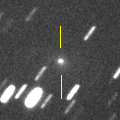
|
It brightened rapidly and became brighter than expected. Now it is 16.9 mag (Mar. 18, Toshihiko Ikemura, Hirohisa Sato). It is observable in good condition in the Northern Hemisphere. It locates somewhat low in the Southern Hemisphere.
Date(TT) R.A. (2000) Decl. Delta r Elong. m1 Best Time(A, h)
Mar. 20 4 56.32 20 27.6 2.029 2.029 75 17.1 19:35 ( 76, 54)
Mar. 27 5 11.31 20 5.5 2.119 2.050 72 17.2 19:42 ( 79, 50)
|
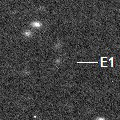
|
First return of a new periodic comet which brightened up to 16 mag in 2014. Now it is 17.0 mag (Mar. 17, Toshihiko Ikemura, Hirohisa Sato). It will brighten up to 17 mag in spring, and it will be observable in good condition.
Date(TT) R.A. (2000) Decl. Delta r Elong. m1 Best Time(A, h)
Mar. 20 12 46.84 13 1.8 1.360 2.329 162 17.2 0:58 ( 0, 68)
Mar. 27 12 40.56 12 56.4 1.334 2.309 163 17.1 0:24 ( 0, 68)
|

|
Now it is 18.2 mag (Mar. 11, A. C. Gilmore, P. M. Kilmartin). It is expected to brighten up to 12 mag in 2022. In the Southern Hemisphere, it stays observable in good condition for a long time. In the Northern Hemisphere, it is not observable until 2022 autumn.
Date(TT) R.A. (2000) Decl. Delta r Elong. m1 Best Time(A, h)
Mar. 20 2 45.92 -43 23.2 6.307 5.827 57 17.2 19:35 ( 44,-11)
Mar. 27 2 48.26 -42 55.9 6.277 5.778 55 17.1 19:42 ( 48,-16)
|
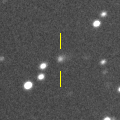
|
Now it is 17.8 mag (Mar. 16, Toshihiko Ikemura, Hirohisa Sato). Fading slowly. In 2021, it stays observable at 17-18 mag in good condition until early summer.
Date(TT) R.A. (2000) Decl. Delta r Elong. m1 Best Time(A, h)
Mar. 20 13 9.63 -18 37.7 6.004 6.913 154 17.5 1:21 ( 0, 36)
Mar. 27 13 7.78 -18 8.4 5.977 6.927 160 17.5 0:51 ( 0, 37)
|
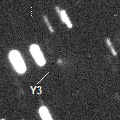
|
Now it is 16.8 mag (Mar. 14, Toshihiko Ikemura, Hirohisa Sato). It stays 17.5 mag and observable in good condition until March.
Date(TT) R.A. (2000) Decl. Delta r Elong. m1 Best Time(A, h)
Mar. 20 14 53.70 30 10.8 1.615 2.367 128 17.5 3:04 ( 0, 85)
Mar. 27 14 47.73 35 17.6 1.653 2.411 129 17.6 2:31 (180, 90)
|
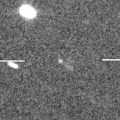
|
Now it is 16.8 mag (Mar. 14, Toshihiko Ikemura, Hirohisa Sato). It is expected to brighten up to 10 mag in 2023. In the Northern Hemisphere, it stays observable in good condition until 2023 autumn. In the Southern Hemipshere, it stays extremely low until mid July, then it becomes unobservable for a while. But it becomes observable in good condition after 2023 summer.
Date(TT) R.A. (2000) Decl. Delta r Elong. m1 Best Time(A, h)
Mar. 20 12 55.25 35 58.6 6.900 7.708 141 17.6 1:06 (180, 89)
Mar. 27 12 50.25 36 41.3 6.861 7.656 140 17.5 0:34 (180, 88)
|

|
Now it is 17.4 mag (Mar. 14, Toshihiko Ikemura, Hirohisa Sato). It stays 17-18 mag for a long time from 2021 to 2023.
Date(TT) R.A. (2000) Decl. Delta r Elong. m1 Best Time(A, h)
Mar. 20 10 47.07 11 51.1 3.982 4.925 159 17.5 22:54 ( 0, 67)
Mar. 27 10 44.08 12 3.5 4.018 4.918 151 17.6 22:24 ( 0, 67)
|
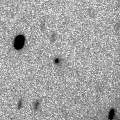
|
Now it is 17.4 mag (Mar. 18, Toshihiko Ikemura, Hirohisa Sato). It will approach to Earth down to 0.2 a.u. in December, and it is expected to brighten up to 4 mag. In the Northern Hemisphere, it stays observable in good condition for a long time until December while the comet is brightening gradually. In the Southern Hemisphere, it is not observable until mid December.
Date(TT) R.A. (2000) Decl. Delta r Elong. m1 Best Time(A, h)
Mar. 20 13 16.98 58 28.6 3.701 4.283 119 17.7 1:28 (180, 67)
Mar. 27 13 1.58 59 47.6 3.655 4.206 117 17.6 0:46 (180, 65)
|
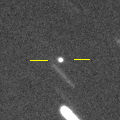
|
Now it is 16.9 mag (Mar. 10, Toshihiko Ikemura, Hirohisa Sato). It will be fading after this, and will be fainter than 18 mag in April. In the Northern Hemisphere, it stays observable in good condition for a long time after this. In the Southern Hemisphere, it will never be unobservable after this.
Date(TT) R.A. (2000) Decl. Delta r Elong. m1 Best Time(A, h)
Mar. 20 3 32.78 42 45.3 1.884 1.711 64 17.6 19:35 (118, 45)
Mar. 27 3 57.56 43 55.7 1.972 1.757 62 17.7 19:42 (120, 44)
|

|
Now it is 17.1 mag (Mar. 18, Toshihiko Ikemura, Hirohisa Sato). Although it is an asteroid, it is brightening rapidly. It stays 17-18 mag for a long time from 2021 to 2022. In the Southern Hemisphere, it stays observable in good condition for a long time. In the Northern Hemisphere, it is observable only until May.
Date(TT) R.A. (2000) Decl. Delta r Elong. m1 Best Time(A, h)
Mar. 20 8 31.55 -6 55.7 4.947 5.617 128 17.7 20:39 ( 0, 48)
Mar. 27 8 27.22 -6 59.8 5.020 5.601 121 17.7 20:07 ( 0, 48)
|

|
First return of a new periodic comet observed at 19 mag in 2015. Now it is 17.8 mag (Mar. 4, Giuseppe Pappa). It will brighten up to 17 mag in early summer, and it will be observable in good condition.
Date(TT) R.A. (2000) Decl. Delta r Elong. m1 Best Time(A, h)
Mar. 20 17 17.05 -11 11.0 1.006 1.532 99 17.9 4:39 (344, 42)
Mar. 27 17 35.93 -11 16.4 0.954 1.517 102 17.7 4:29 (343, 42)
|
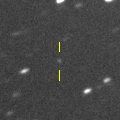
|
Now it is 17.7 mag (Mar. 7, ATLAS-MLO, Mauna Loa). It stays observable at 18 mag for a long time until 2024.
Date(TT) R.A. (2000) Decl. Delta r Elong. m1 Best Time(A, h)
Mar. 20 15 28.26 -11 44.3 8.624 9.249 126 17.8 3:39 ( 0, 43)
Mar. 27 15 25.04 -11 21.2 8.516 9.237 134 17.8 3:08 ( 0, 44)
|

|
It stays 17-18 mag for a long time until 2026. In the Southern Hemisphere, it stays sobservable in good condition for a long time. It is not observable in the Northern Hemisphere. Now it is 19.7 mag (Mar. 13, A. C. Gilmore, P. M. Kilmartin), fainter than this ephemeris.
Date(TT) R.A. (2000) Decl. Delta r Elong. m1 Best Time(A, h)
Mar. 20 9 4.32 -56 55.3 11.098 11.526 113 17.8 21:11 ( 0, -2)
Mar. 27 9 0.38 -56 38.6 11.089 11.509 112 17.8 20:40 ( 0, -2)
|

|
Now it is 17.7 mag (Mar. 7, ATLAS-MLO, Mauna Loa). Although it is around the aphelion, it is much brighter than originally predicted.
Date(TT) R.A. (2000) Decl. Delta r Elong. m1 Best Time(A, h)
Mar. 20 10 58.59 10 7.9 4.441 5.398 162 18.0 23:06 ( 0, 65)
Mar. 27 10 54.93 10 20.5 4.483 5.402 154 18.0 22:34 ( 0, 65)
|

|
Marsden group's comet. Three apparitions of this comet was confirmed in 1999, 2004 and 2010. It approached to Sun down to 0.044 a.u. on Feb. 28. After the perihelion passage, it may be observed on the ground from March to April.
Date(TT) R.A. (2000) Decl. Delta r Elong. m1 Best Time(A, h)
Mar. 20 21 23.60 -15 13.2 1.101 0.738 40 22.2 4:39 (292, 4)
Mar. 27 21 16.87 -16 43.0 1.138 0.907 49 23.6 4:29 (296, 8)
|
|
![]()
 117P/Helin-Roman-Alu 1
117P/Helin-Roman-Alu 1 C/2019 K7 ( Smith )
C/2019 K7 ( Smith ) 409P/2020 V1 ( LONEOS-Hill )
409P/2020 V1 ( LONEOS-Hill ) 28P/Neujmin 1
28P/Neujmin 1 C/2020 N1 ( PanSTARRS )
C/2020 N1 ( PanSTARRS ) 398P/2020 P2 ( Boattini )
398P/2020 P2 ( Boattini ) C/2020 M5 ( ATLAS )
C/2020 M5 ( ATLAS ) C/2018 N2 ( ASASSN )
C/2018 N2 ( ASASSN ) C/2020 Y2 ( ATLAS )
C/2020 Y2 ( ATLAS ) P/2020 U2 ( PanSTARRS )
P/2020 U2 ( PanSTARRS ) C/2019 T3 ( ATLAS )
C/2019 T3 ( ATLAS ) C/2020 H6 ( ATLAS )
C/2020 H6 ( ATLAS ) 141P/Machholz 2
141P/Machholz 2 C/2017 Y2 ( PanSTARRS )
C/2017 Y2 ( PanSTARRS ) C/2019 O3 ( Palomar )
C/2019 O3 ( Palomar ) C/2020 S8 ( Lemmon )
C/2020 S8 ( Lemmon ) C/2020 O2 ( Amaral )
C/2020 O2 ( Amaral ) C/2017 U7 ( PanSTARRS )
C/2017 U7 ( PanSTARRS ) A/2019 U5
A/2019 U5 277P/LINEAR
277P/LINEAR 413P/2020 W4 ( Larson )
413P/2020 W4 ( Larson ) C/2020 R7 ( ATLAS )
C/2020 R7 ( ATLAS ) C/2019 C1 ( ATLAS )
C/2019 C1 ( ATLAS ) C/2020 Y3 ( ATLAS )
C/2020 Y3 ( ATLAS ) C/2020 V2 ( ZTF )
C/2020 V2 ( ZTF ) 99P/Kowal 1
99P/Kowal 1 C/2021 A1 ( Leonard )
C/2021 A1 ( Leonard ) 162P/Siding Spring
162P/Siding Spring A/2020 F7
A/2020 F7 417P/2021 B1 ( NEOWISE )
417P/2021 B1 ( NEOWISE ) C/2020 F2 ( ATLAS )
C/2020 F2 ( ATLAS ) C/2019 E3 ( ATLAS )
C/2019 E3 ( ATLAS ) 47P/Ashbrook-Jackson
47P/Ashbrook-Jackson P/1999 J6 = P/2004 V9 = P/2010 H3 ( SOHO )
P/1999 J6 = P/2004 V9 = P/2010 H3 ( SOHO )![]()























































